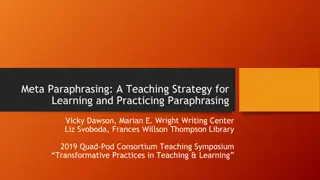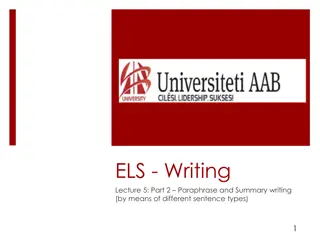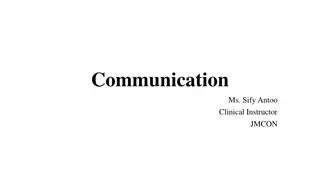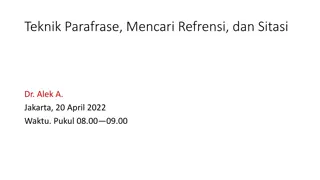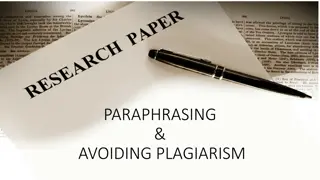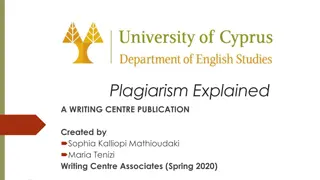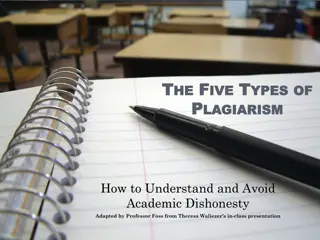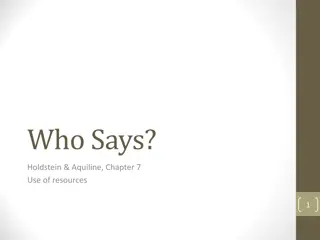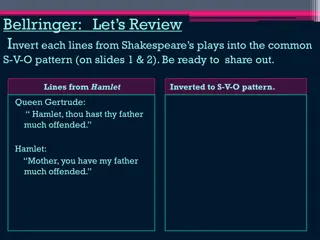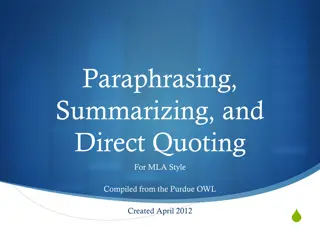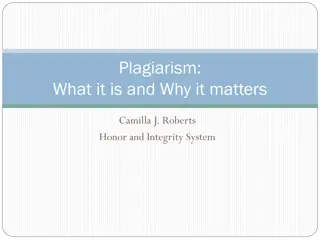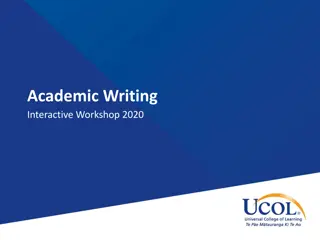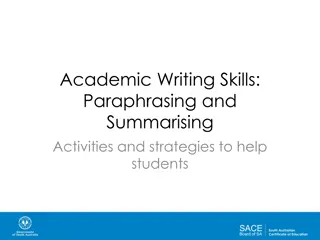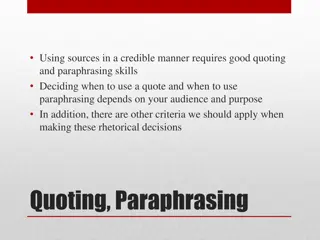Effective Techniques for Paraphrasing Academic Work
Paraphrasing published author's work requires time, understanding, and persistence. Recognize the distinction between quoting and paraphrasing, emphasizing the importance of citations. Avoid excessive quoting in social sciences, preferring paraphrasing. Spend ample time reading and discussing ideas to effectively paraphrase without plagiarism.
Download Presentation

Please find below an Image/Link to download the presentation.
The content on the website is provided AS IS for your information and personal use only. It may not be sold, licensed, or shared on other websites without obtaining consent from the author.If you encounter any issues during the download, it is possible that the publisher has removed the file from their server.
You are allowed to download the files provided on this website for personal or commercial use, subject to the condition that they are used lawfully. All files are the property of their respective owners.
The content on the website is provided AS IS for your information and personal use only. It may not be sold, licensed, or shared on other websites without obtaining consent from the author.
E N D
Presentation Transcript
How to paraphrase a published author s work in your own words.
Understand that paraphrasing is very difficult and should not feel easy. As your readings become more specialized and complex, the harder it is to put key class concepts in your own words. Give yourself ample time to read and understand your essay sources and class materials. Time-management and persistence is key: The more time you spend reading and thinking about the concepts the more confident you will be in your ability to put them in your own words.
Recognize the difference between a quote and a paraphrase. A quote is a section of text lifted directly word for word from its original source. A paraphrase is a re-wording of a section of text in your own voice and writing style. Whether paraphrasing or quoting, you must acknowledge the original text with a citation.
Quote: People who eat red meat tend to have more health problems later in life than vegetarians (Smith, 2011, p.23). Paraphrase: Smith (2011) argues that vegetarians enjoy greater health as they age than meat eaters (p. 23). Notice that both have citations.
Quoting is often discouraged in the social sciences, which means that when you are using sources, you should paraphrase more often than you quote. Quote when (1) the language is so technical that your paraphrase would change the meaning of the original, or (2) you want to emphasize the author s exact words, so that you can make some larger comment about the specifics.
Spend plenty of time reading and thinking about the sources you will use in the essay. If you don t understand, discuss the ideas with your professor or a classmate. Jot down the page numbers and general ideas of the sections you know you will use. In your notes, write author s idea to avoid plagiarism. Within a passage you intend to paraphrase, highlight words or phrases you do not understand. Define the words you do not know. Just having a vague sense is not enough. You need to understand every word and every concept within the passage. If you can explain the passage aloud to yourself or someone else, you are ready to write it.
While proofreading your paraphrase, resist the urge to give up because you think the author just sounds better than you, push through the frustration and keep trying. A clumsy paraphrase, but one that captures the main idea, is better than a paraphrase that sounds good because it adheres too closely to the original. Use the thesaurus sparingly. Paraphrasing gets easier with practice.
Step 1: Before you begin to even write the paraphrase, read the original several times. Step 2: Before writing, say the main ideas to yourself out loud or explain them to a friend. Being able to talk about the idea or repeat it in your own words will help you articulate it in your writing. Step 3: Jot down your ideas as you speak without looking at the text.
Step 4: Put the original away. Do not look at the original as you write. Step 5: Write the first draft of the paraphrase, in your own sentence structure and wording. Do not look at the original as you write. This prevents you from substituting word for word, or copying the original s sentence structure. Try to complete the entire paraphrase without looking.
Step 6: Read the paraphrase checking for these mistakes, while referencing the original: Are there phrases or words copied from the original? Check for word for word substitutions. Make sure you did not rely on the computer s thesaurus to write the entire passage. Have you faithfully repeated the main ideas of the original? Do the sentences make sense? Are your sentence structures different than the original? Does the paraphrase sound like you wrote it? Does it sound too close to the published author s voice? If a few of these questions bring up red flags, it might mean that you do not understand the concepts fully. That is okay and part of the comprehension process. Go back to the original, read it, digest and try again. Try until you really can rewrite the author s ideas without looking at the original.
Step 7: Once you feel satisfied with your work, make sure the paraphrase is cited correctly. Do you have either a signal phrase, such as Smith (2011) states (p.9) or a parenthetical citation (Smith, 2011, p.9)? If you do not cite, your professor will think you have plagiarized. Step 9: Make sure that the paraphrase relates to the topic sentence of the paragraph. Does your paraphrase relate to the ideas within the section or paragraph? Have a writer tutor or a peer read your essay to make sure the paraphrase fits with the other parts of your essay.
Original: With the suspension stiffened by 47 percent over the Echo, the Toyota Yaris feels buttoned-down and, dare we say, fun on curvy roads. The suspension design is nothing earth-shattering-tried-and-true MacPherson struts up front and a torsion beam out back. But with redesigned bushings, a single upper mounting point for the front struts (rather than three as in the Echo), firmer calibrations and a lower center of gravity,the Yaris doesn t even feel related to its wallowing forebear. Taken from Edmunds.com, 2007 Toytota Yaris Review Paraphrase: According to 2007 Toyota Yaris Review, the Yaris has tighter suspension over the Echo and is fun to drive. The suspension is normal for the type of car; however, it has improved bushings, struts calibrations,and a lower center of gravity compared to the Echo (par.7).
Two typical misconceptions: 1) As long as I put a source in my own words I do not need to cite. I only need to cite when I quote. WRONG! 2) As long as I cite, I can copy huge pieces of the original word for word without putting quotations around them, or noting that it is not my words. WRONG! Other Examples . Copying the source word for word and citing the source Using too many of the original s phrases and words Rearranging the sentences without changing any of the words or only a few words Less Obvious: Using the computer s thesaurus to substitute word for word Less Obvious: Copying the sentence structure of the original
Original: Students frequently overuse direct quotation in taking notes, and as a result they overuse quotations in the final [research] paper. Probably only about 10% of your final manuscript should appear as directly quoted matter. Therefore, you should strive to limit the amount of exact transcribing of source materials while taking notes. Lester, James D. Writing Research Papers. 2nd ed. (1976): 46-47. Plagiarized Paraphrase: Students often use too many direct quotations when they take notes, resulting in too many of them in the final research paper. In fact, probably only about 10% of the final copy should consist of directly quoted material. So it is important to limit the amount of source material copied while taking notes (Lester, 1976, pp. 46-47). Examples taken from the Purdue Online Writing Lab
Original: overuse direct quotation in taking notes, Plagiarized: use too many direct quotations when they take notes Original: and as a result Plagiarized: resulting Original: final manuscript Plagiarized: final research paper Original: exact transcribing of source materials Plagiarized: source material copied
Example 1: Original: Students frequently overuse direct quotation in taking notes, and as a result they overuse quotations in the final [research] paper. Plagiarized Paraphrase: Students often use too many direct quotations when they take notes, resulting in too many of them in the final research paper. Desired Paraphrase: In research papers students often quote excessively, failing to keep quoted material down to a desirable level. Example 2: Original: Therefore, you should strive to limit the amount of exact transcribing of source materials while taking notes. (Notice the sentence structure flip and that no words are similar to the original). Plagiarized: So it is important to limit the amount of source material copied while taking notes. Desired Paraphrase: Since the problem usually originates during note taking, it is essential to minimize the material recorded verbatim.
Original: Students frequently overuse direct quotation in taking notes, and as a result they overuse quotations in the final [research] paper. Probably only about 10% of your final manuscript should appear as directly quoted matter. Therefore, you should strive to limit the amount of exact transcribing of source materials while taking notes. Correct: In research papers students often quote excessively, failing to keep quoted material down to a desirable level. Since the problem usually originates during note taking, it is essential to minimize the material recorded verbatim (Lester 46-47). Notice that the placement of ideas has shifted. There is no substitution of words; instead, a complete rephrasing has occurred.
Though this is not plagiarism, your professors with grade down for this mistake. You must repeat all of the main ideas from the passage. Do not write too brief a paraphrase. Ratio should be 1:1. Original: With the suspension stiffened by 47 percent over the Echo, the Toyota Yaris feels buttoned-down and, dare we say, fun on curvy roads. The suspension design is nothing earth-shattering- tried-and-true MacPherson struts up front and a torsion beam out back. But with redesigned bushings, a single upper mounting point for the front struts (rather than three as in the Echo), firmer calibrations and a lower center of gravity, the Yaris doesn t even feel related to its wallowing forebear. Taken from Edmunds.com, 2007 Toytota Yaris Review Bad Paraphrase: The Toyota Yaris is fun to drive on windy roads because the suspension has been stiffened by 47 percent over the Echo ( 2007 Toyota Yaris Review ).
Though this is not plagiarism, again, your profs might grade down for this mistake: Incorrectly using words or creating nonsensical phrases by substituting word for word. The hub of the controversies of bullying revolves around the atmosphere of adolescents within the academic and the emanate involvement in extracurricular activities. Culture has outspokenly been modified with each passing generation, with the spotlight directly placed on the incredible irony depicted throughout these changes.
If you have a passage from your textbook or source that you want to cite which is already cited, and paraphrased, by the textbook authors, find the original if you can. It is very hard to paraphrase a paraphrase. You risk losing the meaning of the original, like a game of telephone.
When we summarize, we condense, in our own words, a substantial amount of material into a short paragraph or perhaps even into a sentence. At other times, and for a variety of reasons, we may wish to restate in detail and in our own words a certain portion of another author s writing. In this case, we must rely on the process of paraphrasing. (Emphasis mine) Unlike a summary, which results in a substantially shorter textual product, a paraphrase usually results in writing of equivalent textual length as the original, but, of course, with a different words and, ideally, different sentence structure. Miguel Roig, Ph.D.Avoiding plagiarism, self-plagiarism, and other questionable writing practices: A guide to ethical writinghttp://facpub.stjohns.edu/~roigm/plagiarism/Index.html
Paraphrase: In research papers students often quote excessively, failing to keep quoted material down to a desirable level. Since the problem usually originates during note taking, it is essential to minimize the material recorded verbatim (Lester, 1976, pp. 46-47). Summary: Students should take just a few notes in direct quotation from sources to help minimize the amount of quoted material in a research paper (Lester, 1976, pp. 46-47).
Miller-Cochran, S.K & Rodrigo, R.L. (2009). The Wadsworth Guide to Research. Mason, OH: Cengage Learning. Roig, M. (2007). Avoiding plagiarism, self-plagiarism, and other questionable writing practices: A guide to ethical writing. Retrieved from: http://facpub.stjohns.edu/~roigm/plagiarism/Index.html The Purdue Online Writing Lab (2012). Paraphrase: Write in your Own Words. Purdue Online Writing Lab. Retrieved from: http://owl.english.purdue.edu/owl/resource/619/1/



